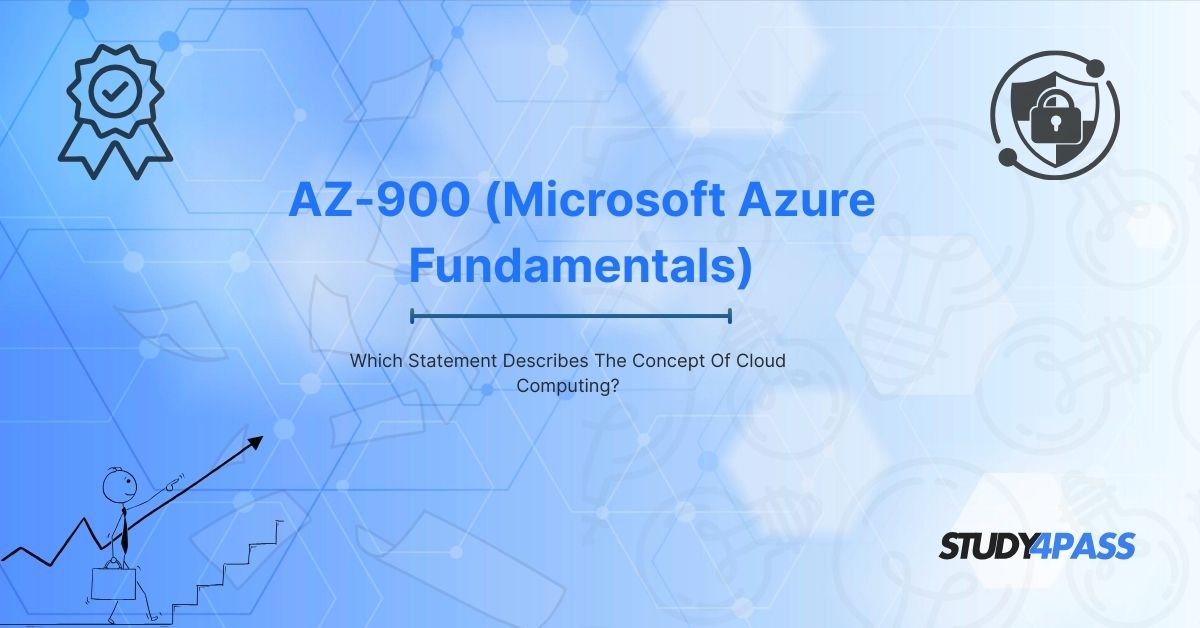Introduction
Cloud computing has revolutionized the way businesses and individuals store, manage, and process data. It eliminates the need for physical infrastructure, offering scalable and cost-effective solutions. For those preparing for the Microsoft Azure Fundamentals (AZ-900) exam, understanding cloud computing is crucial. This article explores the concept of cloud computing, its benefits, deployment models, and service types, while also highlighting how Study4Pass can help you ace the AZ-900 exam.
What is Cloud Computing?
Cloud computing refers to the delivery of computing services—including servers, storage, databases, networking, software, analytics, and intelligence—over the internet ("the cloud"). Instead of owning physical data centers, organizations can rent access to these services from cloud providers like Microsoft Azure, AWS, or Google Cloud.
Key Characteristics of Cloud Computing
- On-Demand Self-Service – Users can provision resources automatically without human intervention.
- Broad Network Access – Services are accessible over the internet from various devices.
- Resource Pooling – Cloud providers use multi-tenant models to serve multiple customers.
- Rapid Elasticity – Resources can be scaled up or down based on demand.
- Measured Service – Users pay only for the resources they consume.
Which Statement Best Describes Cloud Computing?
Several statements can describe cloud computing, but the most accurate one is:
"Cloud computing is the on-demand delivery of IT resources over the internet with pay-as-you-go pricing, eliminating the need for physical infrastructure management."
This definition aligns with Microsoft’s explanation in the AZ-900 exam, emphasizing flexibility, scalability, and cost efficiency.
Cloud Computing Deployment Models
There are three primary cloud deployment models:
1. Public Cloud
- Owned and operated by third-party cloud providers (e.g., Microsoft Azure, AWS).
- Resources are shared among multiple organizations.
- Best for: Startups, small businesses, and scalable applications.
2. Private Cloud
- Dedicated to a single organization.
- Offers greater control and security.
- Best for: Enterprises with strict compliance requirements.
3. Hybrid Cloud
- Combines public and private clouds.
- Allows data and applications to move between environments.
- Best for: Businesses needing flexibility and regulatory compliance.
Cloud Computing Service Models
Cloud services are categorized into three main models:
1. Infrastructure as a Service (IaaS)
- Provides virtualized computing resources over the internet.
- Example: Azure Virtual Machines.
- Use Case: Businesses needing scalable infrastructure without hardware costs.
2. Platform as a Service (PaaS)
- Offers a platform for developing, testing, and deploying applications.
- Example: Azure App Services.
- Use Case: Developers focusing on app development without managing servers.
3. Software as a Service (SaaS)
- Delivers software applications over the internet.
- Example: Microsoft 365, Salesforce.
- Use Case: Organizations using ready-made applications without installation.
Why Cloud Computing is Essential for AZ-900 Exam?
The Microsoft Azure Fundamentals (AZ-900) exam tests foundational knowledge of cloud concepts, including:
- Core Azure services
- Cloud pricing and support
- Security, compliance, and trust
- Azure governance and administration
Understanding cloud computing is the first step toward mastering these topics.
How Study4Pass Helps You Pass the AZ-900 Exam?
Preparing for the AZ-900 exam requires structured learning and practice. Study4Pass offers:
Comprehensive Study Guides – Simplified explanations of cloud concepts.
Practice Tests – Realistic exam simulations to assess your knowledge.
Exam Prep Practice Test – Updated questions based on the latest AZ-900 syllabus.
Interactive Learning – Video tutorials and hands-on labs.
With Study4Pass, you can confidently prepare and pass the AZ-900 exam on your first attempt!
Conclusion
Cloud computing is transforming IT by offering scalable, cost-efficient, and flexible solutions. For the AZ-900 exam, understanding its core principles is essential. Whether you're exploring IaaS, PaaS, or SaaS, or learning about public, private, and hybrid clouds, mastering these concepts will set a strong foundation for your Azure journey.
For the best exam preparation, trust Study4Pass to provide the resources you need to succeed. Start your cloud learning today and unlock new career opportunities in Microsoft Azure!
Special Discount: Offer Valid For Limited Time “AZ-900 Exam Prep Practice Test”
Sample Questions for Microsoft 200-301 Exam Prep Practice Tests
Actual exam questions from Microsoft's 200-301 Exam
1. Which of the following best describes cloud computing?
a) Storing data only on local servers
b) Accessing computing resources over the internet on-demand
c) Using physical hardware for all computing needs
d) Limiting software usage to a single device
2. Cloud computing allows users to:
a) Only run software installed on their personal computers
b) Access data and applications from anywhere with an internet connection
c) Use storage devices connected directly to their machines
d) Avoid using the internet for any computing tasks
3. What is a key feature of cloud computing?
a) Requires users to manage all hardware maintenance
b) Provides scalable and flexible computing resources
c) Only works with offline applications
d) Does not rely on virtualization technology
4. Which statement is true about cloud computing?
a) It eliminates the need for internet connectivity
b) It relies on remote servers hosted on the internet
c) It requires physical delivery of software via CDs/USBs
d) It cannot be used for data storage
5. Cloud computing is beneficial because it:
a) Increases hardware costs for businesses
b) Reduces the need for on-premises IT infrastructure
c) Limits access to data to a single location
d) Slows down software updates


